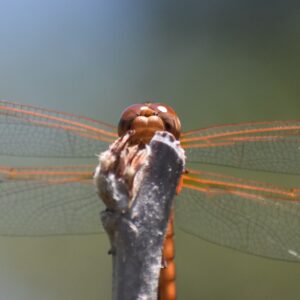Here there be Dragons

This past summer, Crystal Cove witnessed a boom of dragonflies. Their aerial antics could be seen almost everywhere, from patrolling along the Los Trancos Creek to forming large swarms in the Moro Canyon backcountry. Their dances are not merely aesthetic, but the product of a highly adapted insect who plays a key role in Crystal Cove’s ecosystem.
When looking through a dragonfly’s shimmering wings or into their enigmatic eyes, one witnesses the final stage of a life spent mostly underwater. Each spring, female dragonflies lay up to several hundred eggs on aquatic plants. These dragonfly larvae, called nymphs, may molt their exoskeletons up to 15 times before emerging from the water. Once on the wing, they are flawless flyers. Dragonflies have two pairs of transparent wings that work independently, allowing them to hover in one place, fly backwards, and perform aerial loops. Dragonfly flight is complimented by an enormous range of vision, the product of their large compound eyes, which contain up to 25,000 lenses. These impressive adaptations are short lived, because while dragonflies may spend up to five years as aquatic nymphs, they may spend as little as one week as an adult.
Since dragonflies split their time between the water and air, they are important components in two food webs. As nymphs, dragonflies feed on invertebrates and small fish found in the water. As adults, they eat small insects like mayflies, mosquitos, and occasionally larger insects such as butterflies and moths. Dragonflies are not only predators, but also prey. They are vulnerable to large fish and waterfowl as nymphs, and as adults, they can be consumed by birds and spiders. At no point is a dragonfly more vulnerable than immediately after emerging from the water. During this intermediate stage, dragonflies cannot fly well and are susceptible to birds and amphibians.
Dragonflies are a welcome sight at Crystal Cove State Park. Able to consume 100 mosquitos a day, they help control populations of smaller insects. Additionally, dragonfly nymphs can only survive in healthy bodies of water, so the abundance of dragonflies this season could be an indicator of a thriving freshwater ecosystem.
